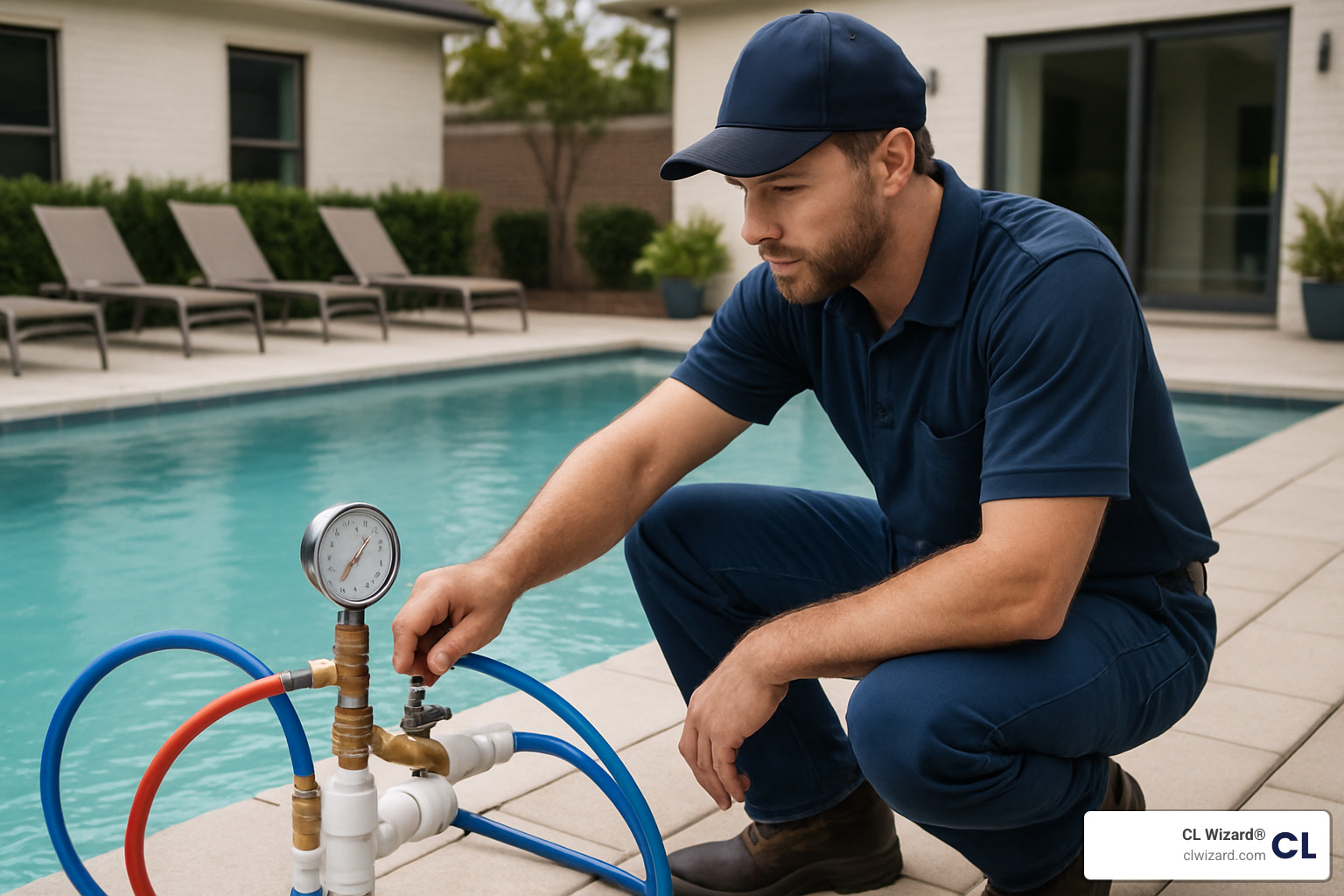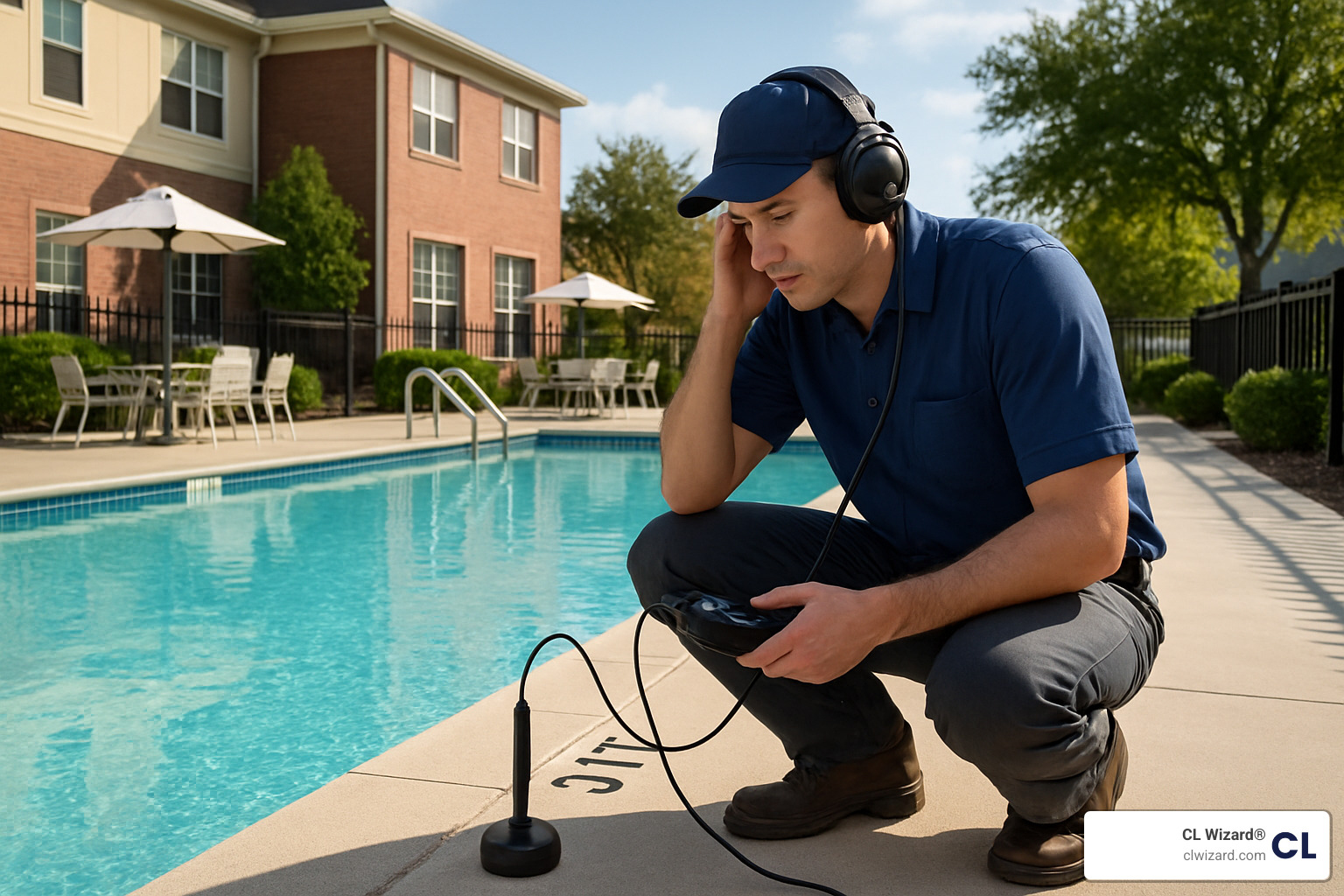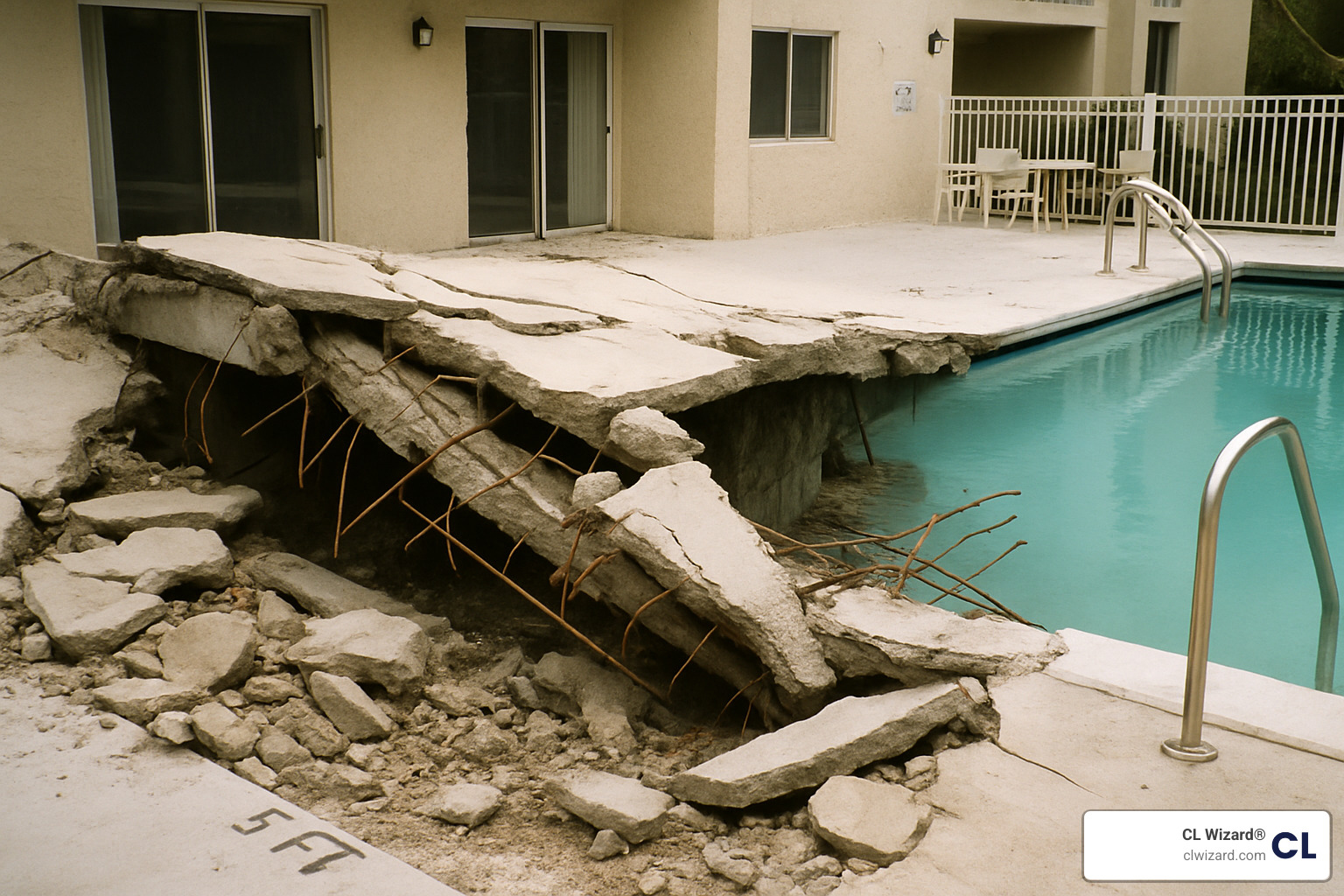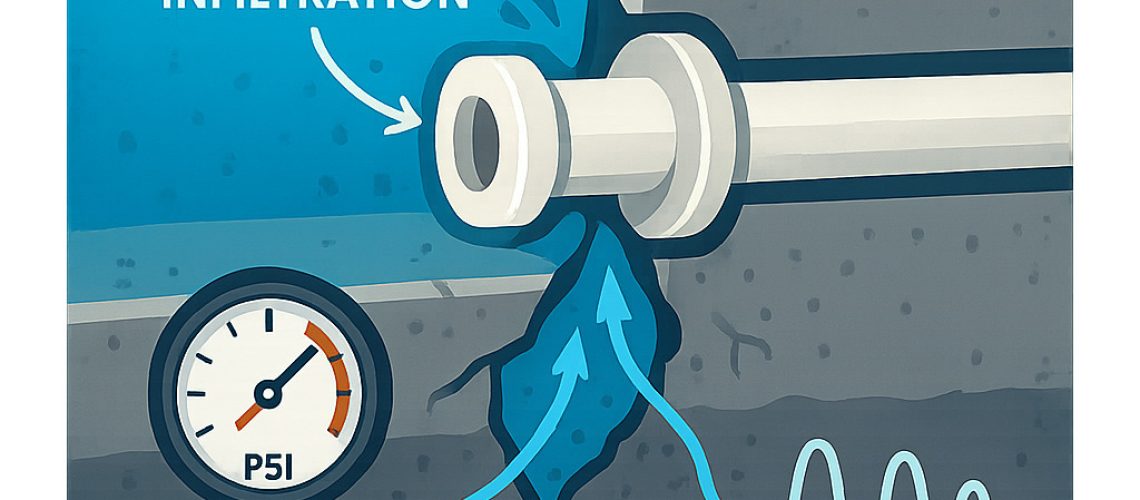The Silent Threat: Identifying Pool Return Line Leaks
To find leak in pool return line, follow these steps:
- Visual inspection: Look for wet spots around the pool deck near return line areas
- Bucket test: Compare water loss between a bucket and pool to determine if water loss exceeds evaporation
- Pressure test: Isolate and pressurize return lines to 15-20 PSI maximum to identify leaks
- Dye test: With pump off, inject dye near suspected leak areas to see if it gets pulled in
- Listen for leaks: Use acoustic detection through deck surfaces to pinpoint underground leaks
If you’re losing more than a quarter-inch of water daily, you likely have a leak that needs professional attention.
When managing high-value properties in South Florida, few maintenance issues can be as deceptively destructive as a find leak in pool return line situation. The concrete structures supporting your pool systems are particularly vulnerable to water infiltration in our humid climate.
Pool return lines – the pipes that push filtered water back into your pool – are critical components that often develop leaks over time. These leaks can be surprisingly challenging to locate, as they’re typically buried under concrete decking or within the pool structure itself.
“If you’re losing more than a quarter-inch of water from your pool each day, you could have a dreaded leak on your hands,” notes a leading industry report. This water loss isn’t just an inconvenience – it’s a signal of potentially serious structural problems developing beneath the surface.
For property managers overseeing apartment complexes, condominiums, or commercial facilities with pools, these leaks represent more than just water waste. They can undermine surrounding concrete, create liability issues, and lead to extensive property damage if left unaddressed.
Unlike typical concrete repair methods that require disruptive excavation, modern detection techniques can precisely locate return line leaks with minimal interference to your property’s operations. The specialized technology employed by concrete leak specialists can pinpoint leaks to within a 3-4 foot section, allowing for targeted repairs that don’t require extensive demolition.
Rather than attempting temporary DIY fixes that ultimately fail, professional concrete water infiltration experts can provide permanent solutions that address the root cause of pool return line leaks.

Common find leak in pool return line vocab:
– fixing leaks in underground pool pipes
– water leak detector for pools
– leak detection company for pools
How to find leak in pool return line: Professional Diagnostic Roadmap
South Florida’s unique climate creates special challenges for pool owners. The combination of high humidity, occasional extreme weather, and concrete’s naturally porous nature creates the perfect storm for water infiltration issues. Before jumping to conclusions about a leak, it’s important to understand the difference between normal evaporation and an actual problem.
Did you know that in our hot Florida weather, pools can naturally lose up to 1.5″ to 2″ of water weekly through evaporation alone? Anything beyond this threshold likely points to a leak that requires professional attention.
Initial checks to find leak in pool return line vs. normal evaporation
The simple yet effective bucket test is your first line of defense in determining whether water loss is due to evaporation or a leak:
Place a bucket filled with pool water on a pool step (this ensures it faces the same environmental conditions as your pool). Mark the water level both inside the bucket and on your pool wall, then wait 24-48 hours before comparing the water loss in both. If your pool shows significantly more water loss than the bucket, you’re dealing with a leak, not just evaporation.
For property managers overseeing commercial or multi-unit residential properties, this simple test can save thousands in unnecessary exploratory work. Remember the quarter-inch rule – if you’re losing more than a quarter-inch of water daily, this exceeds normal evaporation in most conditions and signals a leak requiring professional attention.
For the most accurate measurement results, mark the waterline with waterproof tape and conduct tests during periods of minimal use. Don’t forget to account for climate variables (higher temperatures and wind increase evaporation) and turn off auto-fill systems during testing.
Pressure testing to find leak in pool return line without excavation
Once we’ve confirmed a leak exists, pressure testing becomes our most reliable method to pinpoint its location without destructive excavation. This is particularly valuable for commercial properties and condominiums where minimizing disruption is essential to daily operations.

Our professional approach follows a careful sequence that protects your plumbing while delivering accurate results. We begin by isolating the return lines, shutting off the circulation system and closing all valves. The water-first/air-second sequence is critical – we fill the line with water to purge air before carefully introducing air pressure for the most accurate results.
Controlled pressure is essential – we never exceed 15-20 PSI, as higher pressure can damage PVC pipes and create new leaks. By monitoring pressure drop carefully, we can determine both the presence and severity of leaks. The rate at which pressure falls tells us a lot about what we’re dealing with.
By systematically isolating different sections of the return line, we narrow down the leak location to a specific area, all without draining your pool or disrupting normal use. This non-invasive approach is particularly valuable for large properties throughout Hollywood, Miami, Boca Raton, West Palm Beach, and Delray Beach, saving both time and preventing the headaches associated with traditional repair methods.
More info about detecting leaks in swimming pools
Key Signs Your Pool Return Line Is Leaking
Spotting a return line leak early can save your property from serious concrete damage. Here are the clear indicators that you need to find leak in pool return line issues before they worsen:
Bubbles in return jets
When you see consistent air bubbles coming from your return jets while the pump runs, pay attention. While a few bubbles might appear after routine maintenance like backwashing, persistent bubbles typically signal a suction-side air leak that needs expert assessment. For large properties, these small signs can be early warnings of bigger problems developing underground.
Soggy deck spots or erosion
Notice wet patches or softening around your pool deck? These areas, especially near return line fittings, are red flags for underground leaks. This is particularly concerning for commercial properties and condominiums, as water silently infiltrating concrete structures can gradually compromise their structural integrity.

Leaks that occur only when the pump runs
If you’re noticing water loss primarily during circulation system operation, you’re likely dealing with a pressure-side leak in the return plumbing. Professionals refer to this as “Leak Test Condition 4” – a clear indicator that the issue lies within the pressurized section of your plumbing rather than the pool shell itself. This distinction is crucial for proper diagnosis and repair.
Algae blooms near returns
Unusual algae growth concentrated around your return fittings isn’t just a cleaning issue – it’s often an early warning sign of a small leak. These minor leaks introduce nutrients that feed algae, creating these telltale growth patterns. By the time you notice these blooms, water has likely been escaping for some time.
Chemical imbalance and increased treatment needs
Suddenly using more chemicals to maintain proper water balance? A leak may be introducing contaminants or diluting your carefully balanced pool water. For commercial property managers who must maintain strict health and safety standards, these chemical fluctuations can signal costly problems developing beneath the surface.
Rising utility bills
For property managers overseeing large facilities, unexplained increases in water bills often provide the first quantifiable evidence of significant leaks. The financial impact of ignoring these signs can be substantial, especially for properties with large pool systems in South Florida’s year-round swimming climate.
Distinguishing pressure-side leaks from suction-side air bubbles
Understanding the difference between pressure-side leaks (in return lines) and suction-side air leaks is essential for proper diagnosis:
Return-side symptoms include water loss primarily during pump operation, saturated ground near return lines, and fluctuating pressure gauge readings. These issues typically indicate water escaping from the system after it passes through the pump.
Suction-side symptoms manifest as air bubbles in return jets, pumps that struggle to maintain pressure or lose prime, unusual pump noise, and inconsistent water levels in the pump basket. These symptoms point to air being drawn into the system before water reaches the pump.
For large commercial properties throughout South Florida, correctly identifying which type of leak you’re facing is crucial for effective treatment. At CL Wizard®, we use specialized equipment including ground microphones and our proprietary technology to precisely locate leaks without the mess or disruption of older detection methods like dye or smoke tests.
Our advanced techniques allow us to pinpoint return line leaks with minimal interference to your property’s daily operations – a critical advantage for busy commercial facilities, condominiums, and apartment complexes where pool closures directly impact resident satisfaction and property value.
Advanced Non-Invasive Detection Techniques
For large commercial properties, condominiums, and apartment complexes in South Florida, finding pool return line leaks without disrupting operations is essential. At CL Wizard®, we employ cutting-edge non-invasive detection technologies that locate leaks with pinpoint accuracy while allowing your pool to remain in operation.
Our specialized equipment includes a range of sophisticated tools that make finding hidden leaks much simpler than traditional methods. Acoustic sensors can detect the unique sound signature of water escaping from a pressurized pipe, even through concrete decking or soil. These sensitive devices filter out background noise, revealing leaks that would be impossible to spot with the naked eye.
We also use thermal cameras that detect subtle temperature differences caused by leaking water. As water flows through concrete structures, it changes the temperature of surrounding materials – our infrared technology makes these invisible paths visible, showing us exactly where water infiltration is occurring.
One of our most valuable tools for commercial properties are our ground microphones. These specialized listening devices can detect the sound of underground leaks through several feet of concrete and soil. When you need to find leak in pool return line without tearing up expensive decking, this technology pinpoints issues to within a 3-4 foot section, minimizing any disruption.

For underwater issues, our sonar sticks allow us to locate leaks in pool shells and return fittings without draining the pool. This is particularly valuable when pool closure would impact your residents or guests – your amenity stays operational while we identify the problem.
In particularly challenging cases, we can introduce harmless tracer gas into the plumbing system. These gases escape through even the smallest leaks and can be detected with specialized sensors at the surface, revealing problems that other methods might miss.

These technologies represent a significant improvement over traditional leak detection that often required extensive excavation or pool drainage. For property managers in Miami, Boca Raton, or anywhere in South Florida, our non-invasive approaches minimize disruption while delivering accurate results.
Latest research on acoustic leak detection
Locating underground leaks beneath concrete slabs
When pool return lines run beneath concrete decking, finding leaks becomes especially challenging. Our specialized approach takes the guesswork out of the process. We use deck plates and acoustic listening devices that can hear water escaping through up to 6 feet of concrete and compacted soil. By methodically scanning the deck surface, we can identify the exact location where water is escaping.
For pipes running deeper underground, our sonar probes help map the exact path of plumbing and identify anomalies that indicate leaks. This technology is particularly valuable for older properties where original plumbing plans may be unavailable or inaccurate.
The precision of our equipment allows us to narrow down leak locations to within a 3-4 foot section. This means minimal disruption to your property – no need to tear up large sections of decking on a hunch. And because our detection methods don’t require permits, we can typically complete the diagnostic process much faster than traditional methods – a huge benefit when pool downtime affects resident satisfaction.
More info about underground repairs
Trenchless and injection-based repair options once leak is located
Once we’ve precisely located your pool return line leak, CL Wizard® offers a solution that eliminates the need for destructive excavation or pool drainage. Our proprietary polyvinyl injection method is uniquely suited for concrete water infiltration issues.
The process begins with minimally invasive access – we create only small access points to reach the leak location, preserving your property’s aesthetics. Then, we apply our specialized injection technique. What makes our approach is that our polyvinyl liquid initially has the same properties as water, allowing it to flow exactly where water does – finding even the smallest pathways through concrete.
Once in place, the material transforms, permanently sealing the leak by hardening into a rubber-like substance. This creates a waterproof barrier that will last for years, not months. Best of all, repairs can be made while the pool remains in use – no need to disappoint residents with lengthy pool closures.
Another significant advantage for property managers: no permits needed. Unlike traditional concrete demolition and rebuilding, our method doesn’t require time-consuming permits, allowing us to complete repairs faster and with less bureaucratic hassle.
This advanced approach is particularly valuable for large commercial properties, condominiums, and apartment complexes where traditional repair methods would cause significant disruption and downtime. When you need to find leak in pool return line issues and solve them permanently, our non-invasive technology provides the ideal solution.
Risks of Ignoring a Return Line Leak vs. Acting Now
When you manage large properties in South Florida, a pool return line leak isn’t just an inconvenience—it’s a ticking time bomb for your building’s structural integrity. As property managers of condos, apartment complexes, and commercial buildings know all too well, what starts as a small leak can quickly escalate into a major headache.
Structural undermining
Water from leaking return lines doesn’t simply evaporate and disappear. Instead, it silently infiltrates the surrounding soil and concrete, creating a cascade of problems:
The water slowly erodes the soil supporting your pool deck and nearby structures. Over time, these erosion patterns create hidden voids beneath concrete surfaces. As these voids grow, the concrete loses its foundation support, leading to settling, cracking, and potential structural failure.
“We’ve seen cases where what started as a tiny return line leak eventually compromised an entire pool structure,” notes Marco Aurelio, founder of CL Wizard®. “In South Florida’s unique soil conditions, water infiltration can be particularly destructive, sometimes even contributing to sinkhole formation.”
Accelerated concrete decay
Concrete might seem impenetrable, but it’s naturally porous. When consistently exposed to water infiltration, several destructive processes begin working against you:
Rebar corrosion occurs inside concrete structures as water reaches the metal reinforcement. This corrosion expands the metal, creating internal pressure that leads to concrete spalling and deterioration. The ongoing moisture exposure weakens structural components, making them increasingly vulnerable to further water damage.
In South Florida’s humid climate, this deterioration happens faster than in drier regions, accelerating the timeline from minor leak to major repair.
Skyrocketing water bills
For commercial properties and large residential complexes, the financial impact hits your bottom line hard:
A single quarter-inch return line leak can waste thousands of gallons monthly, sending your water bills through the roof without any visible explanation. You’ll also face increasing chemical treatment costs as you constantly add chemicals to compensate for dilution. Meanwhile, your pumps work overtime trying to maintain proper circulation, driving up energy costs.
Liability concerns for property managers
Beyond the physical and financial impacts, ignored pool leaks create significant liability issues that keep property managers up at night:
Unstable deck areas create dangerous trip hazards for residents and guests. Weakened structures may fail unexpectedly during use. Water damage can spread to adjacent units or common areas, multiplying your problems. Perhaps most concerning, failure to address known issues might constitute negligence in legal proceedings.

Cost comparison: delay vs immediate professional intervention
When weighing your options, the financial equation strongly favors prompt professional intervention with CL Wizard®:
Delaying repairs means accepting a host of hidden costs: those escalating water bills (potentially thousands per month), increasing chemical expenses, and the inevitable emergency repairs at premium rates when the problem finally becomes unbearable. You might also face potential litigation from property damage or injuries, decreased property values, and resident dissatisfaction that impacts occupancy rates.
In contrast, immediate intervention from CL Wizard® offers clear advantages: we precisely locate leaks without destructive investigation, implement our permanent polyvinyl injection solution, and complete repairs with no disruption to pool operations. Our work requires no permits, which dramatically speeds up the process. Most importantly, you prevent secondary damage to surrounding structures and secure long-term operational savings.
For property managers across Hollywood, Miami, Boca Raton and the entire South Florida region, our approach isn’t just a repair solution—it’s a sound financial decision that protects your investment and prevents cascading problems before they start.
By addressing return line leaks promptly with our proprietary technology, you avoid the frustrating cycle of repeated patch failures that’s so common with traditional methods. Instead of just treating symptoms, our permanent solution addresses the root cause of water infiltration through concrete, giving you lasting peace of mind.
Frequently Asked Questions about Pool Return Line Leaks
How can I confirm a leak without draining the pool?
This is one of the most common questions we hear from worried property managers who simply can’t afford pool downtime. Good news – you don’t need to drain your pool to confirm a leak!
At CL Wizard®, we use several clever non-invasive techniques that keep your pool fully operational during diagnosis:
The bucket test is our starting point – this simple comparative test quickly tells us if your water loss exceeds normal evaporation. It’s surprisingly accurate and takes just 24-48 hours to complete.
We also use dye testing when we suspect a specific location. With the circulation system temporarily off, we inject non-toxic dye near suspicious areas. It’s actually quite fascinating to watch – if there’s a leak, the dye gets pulled right into it, creating a visual confirmation that’s unmistakable.
Our pressure testing approach is particularly gentle on your plumbing. By isolating and pressurizing return lines to safe levels (we never exceed 20 PSI), we can identify leaks without risking damage to older pipes.
For large commercial properties throughout South Florida, from Miami to West Palm Beach, our approach means your residents can continue enjoying the pool while we solve the problem happening beneath the surface.
What tools do professionals use that DIY kits lack?
While those DIY leak detection kits at the pool store might seem tempting, they simply can’t compare to professional equipment – especially for commercial properties with complex plumbing systems.
Think of it like comparing a home stethoscope to hospital-grade medical equipment. Our professional tools include high-sensitivity hydrophones that can detect underwater sounds impossible for human ears to hear. Our ground microphones can “listen” through several feet of concrete and soil, picking up the distinctive sound of escaping water.
We also use sophisticated electronic leak detection amplifiers that filter out background noise and zero in on the specific sound frequencies that indicate a leak. On particularly challenging jobs, our thermal imaging cameras reveal temperature differences caused by water movement, showing us hidden leak paths that would otherwise be invisible.
Behind every tool is a technician with specialized expertise in South Florida’s unique building materials and environmental conditions. That combination of technology and knowledge simply can’t be replicated with a DIY approach.
Why is low-pressure testing (≤ 20 PSI) critical for PVC safety?
This is perhaps the most important safety consideration that many property managers don’t realize – and it could save you thousands in unnecessary damage.
Your pool’s plumbing typically operates between 10-15 PSI during normal operation. While technical specifications might suggest PVC pipe can handle much higher pressures (schedule 40 PVC is technically rated for up to 198 PSI for 1.5″ pipe), the reality in South Florida’s aging buildings is quite different.
Over time, PVC becomes increasingly brittle due to our intense sun exposure and chemical exposure. Those glued joints that connect pipe sections become vulnerable points that can catastrophically fail under excessive pressure. Add in the effects of thermal expansion and ground settlement that creates stress points, and you have a recipe for disaster if tested improperly.
That’s why at CL Wizard®, we never exceed 20 PSI during pressure testing. This careful approach provides all the diagnostic information we need without creating new problems in your plumbing system. We’ve seen too many cases where overly aggressive testing by others has turned a simple leak into a major emergency.
Our proprietary methods allow for precise leak location without risking further damage to your pool infrastructure – just one more way the CL Wizard® approach protects your property investment while solving your water infiltration problems.
Conclusion
Finding and fixing leaks in pool return lines isn’t just another maintenance task—especially for those managing large commercial properties, condominiums, and apartment complexes across South Florida. Our unique climate and building materials create challenges that demand specialized solutions.
At CL Wizard®, we’ve revolutionized concrete water infiltration repair through innovation and expertise. Our founder, Marco Aurelio, has dedicated his career to developing techniques specifically designed for South Florida’s unique challenges, resulting in solutions that traditional methods simply can’t match.
What makes the CL Wizard® approach truly different is our proprietary polyvinyl injection technology. This remarkable liquid initially shares the same properties as water, allowing it to travel exactly where water infiltrates through concrete. Then, the magic happens—it transforms into a rubber-like substance that creates a permanent seal against future water intrusion.
Unlike conventional repair companies that rely on outdated methods, we’ve developed our own specialized equipment that pinpoints and repairs leaks with surgical precision. No sledgehammers, no jackhammers, and most importantly—no unnecessary destruction of your property.
Perhaps most valuable for busy property managers is our permit-free repair process. While traditional methods often require time-consuming permits for demolition and reconstruction, our injection process typically proceeds without permits, dramatically reducing your timeline from problem to solution.
The best part? Many of our repairs can be completed while your pool remains fully operational. This means no downtime for your residents or guests—they can continue enjoying your amenities while we work our magic beneath the surface.
For property managers across Hollywood, Miami, Boca Raton, West Palm Beach, and Delray Beach, the CL Wizard® solution represents more than just a quick fix—it’s a comprehensive, permanent answer to the persistent challenge of concrete water infiltration. Instead of repeatedly patching symptoms with temporary fixes, our technology resolves the underlying issue once and for all, protecting your investment and preventing further structural damage.
When you need to find leak in pool return line issues, don’t settle for methods that will have you calling for repairs again next season. Choose the solution that fixes the problem permanently the first time.
Leak Detection for Pools Near Me
Get a Quote for your Concrete Water Infiltration Repair
Follow us!

